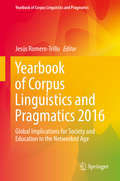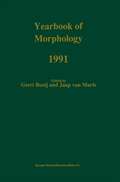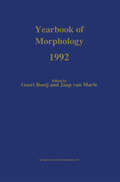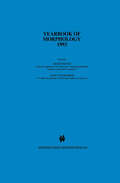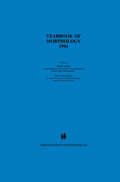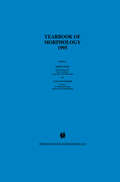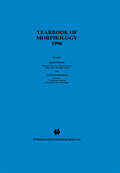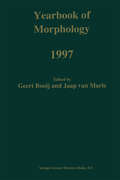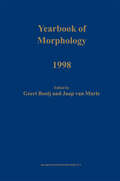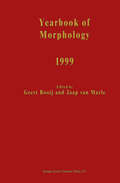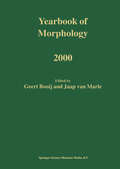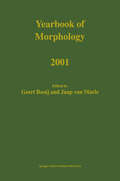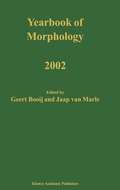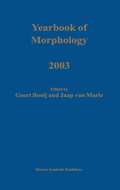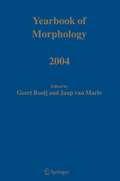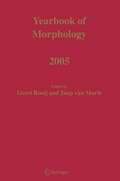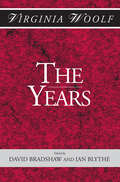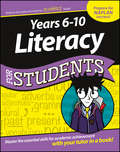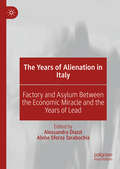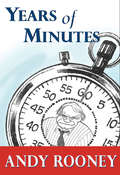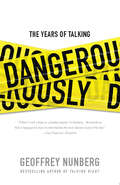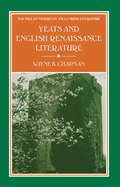- Table View
- List View
Yearbook of Corpus Linguistics and Pragmatics 2016: Global Implications for Society and Education in the Networked Age (Yearbook of Corpus Linguistics and Pragmatics)
by Jesús Romero-TrilloThe present volume of the Yearbook of Corpus Linguistics and Pragmatics series, presents cutting-edge corpus pragmatics research on language use in new social and educational environments.The Yearbook of Corpus Linguistics and Pragmatics offers a platform to scholars who carry out rigorous and interdisciplinary research on language in real use. Corpus Linguistics and Pragmatics have traditionally represented two paths of scientific research, parallel but often mutually exclusive and excluding. Corpus Linguistics can offer a precise methodology based on mathematics and statistics while Pragmatics strives to interpret intended meaning in real language. This series will give readers insight into how pragmatics can be used to explain real corpus data, and how corpora can illustrate pragmatic intuitions.
Yearbook of Morphology 1991 (Yearbook of Morphology)
by G. E. Booij Jaap Van MarleMARK ARONOFF The articles included in this section represent recent research on morpholog ical classes which has been independently performed by a number of investi gators. This work was presented at a symposium that was organized as part of the 1990-1991 annual meeting of the Linguistic Society of America in Chicago in January 1991. Our aim in presenting this work is twofold: on the one hand, we would like to encourage others interested in morphology to pursue the types of research that we present. This is especially important in the study of morphological classes, which, while they are widespread among the languages of the world, are also highly diverse and often quite complex. On the other hand, we hope to convince researchers in adjacent areas to provide a place for autonomous morphology in their general picture of the workings of language and to pay closer attention to the intricacies of the interactionbetweenmorphologyand theseareas.
Yearbook of Morphology 1992 (Yearbook of Morphology)
by Geert Booij Jaap Van MarleA revival of interest in morphology has taken place during recent years and the subject is seen now as a relatively autonomous subdiscipline of linguistics. As one of the important areas of theoretical research in formal linguistics, morphology has attracted linguists to investigate its relations to syntax, semantics, phonology, psycholinguistics and language change. The aim of the Yearbook of Morphology, therefore, is to support and enforce the upswing of morphological research and to give an overview of the current issues and debates at the heart of this revival.
Yearbook of Morphology 1993 (Yearbook of Morphology)
by Geert Booij Jaap Van MarleRecent years have seen a revival of interest in morphology. The Yearbook of Morphology series supports and enforces this upswing of morphological research and gives an overview of the current issues and debates at the heart of this revival. The Yearbook of Morphology 1993 focuses on prosodic morphology, i.e. the interaction between morphological and prosodic structure, on the semantics of word formation, and on a number of related issues in the realm of inflection: the structure of paradigms, the relation between inflection and word formation, and patterns of language change with respect to inflection. There is also discussion of the relevance of the notion `level ordering' for morphological generalizations. All theoretical and historical linguists, morphologists, and phonologists will want to read this volume.
Yearbook of Morphology 1994 (Yearbook of Morphology)
by Geert Booij Jaap Van MarleRecent years have seen a revival of interest in morphology. The Yearbook of Morphology series supports and enforces this upswing of morphological research and gives an overview of the current issues and debates at the heart of this revival. The Yearbook of Morphology 1994 focuses on prosodic morphology, i.e. the interaction between morphological and prosodic structure, on the semantics of word formation, and on a number of related issues in the realm of inflection: the structure of paradigms, the relation between inflection and word formation, and patterns of language change with respect to inflection. There is also discussion of the relevance of the notion `level ordering' for morphological generalizations. All theoretical and historical linguists, morphologists, and phonologists will want to read this book.
Yearbook of Morphology 1995 (Yearbook of Morphology)
by JaapMarle GeertBooijA revival of interest in morphology has occurred during recent years. The aim of the Yearbook of Morphology series is to support and enforce this upswing of morphological research and to give an overview of the current issues and debates at the heart of this revival. The Yearbook of Morphology 1995 focuses on an important issue in the current morphological debate: the relation between inflection and word formation. What are the criteria for their demarcation, in which ways do they interact and how is this distinction acquired by children? The papers presented here concur in rejecting the `split morphology hypothesis' that claims that inflection and word formation belong to different components of the grammar. This volume also deals with the marked phenomenon of subtractive morphology and its theoretical implications. Theoretical and historical linguists, morphologists, phonologists and psycholinguists interested in linguistic issues will find this book of interest.
Yearbook of Morphology 1996 (Yearbook of Morphology)
by JaapMarle GeertBooijA revival of interest in morphology has occurred during recent years. Since 1988, the Yearbook of Morphology book series has proven to be an eminent platform for the growth of morphological research, containing articles on topics that are central in the current theoretical debates. The Yearbook of Morphology 1996 focuses on the relationship between morphology and psycholinguistics. Basic questions such as the following are discussed. To what extent does the morphological structure of a word play a role in its perception and production? Are regular complex words created anew each time they are used, or are they stored in the lexicon? The relevant evidence comes from a variety of European languages. Another important theme in this yearbook is the degree of autonomy of morphology: in which respect does it differ from other modules of the grammar? The present yearbook also contains articles on periphrasis, the nature of inflectional morphology and syncretism in derivational morphology. Audience: Theoretical and historical linguists, morphologists, phonologists and psycholinguists will find this book of interest.
Yearbook of Morphology 1997 (Yearbook of Morphology)
by G. E. Booij Jaap Van MarleInterest in morphology has revived in recent years and the Yearbook of Morphology has provided great support for this revival, with its articles on topics that are central to the current theoretical debates. The Yearbook of Morphology 1997 focuses on the relationship between morphology and other modules of the grammar, especially phonology, syntax and semantics. Among the basic questions discussed are: how does morphology differ from other modules of the grammar, syntax in particular? What are the possible forms of interaction between the modules? How does semantics constrain formal variation in morphology? The evidence adduced is derived from a variety of languages. Audience: Theoretical, descriptive and historical linguists, morphologists, phonologists, and psycholinguists.
Yearbook of Morphology 1998 (Yearbook of Morphology)
by G. E. Booij Jaap Van MarleA revival of interest in morphology has occurred during recent years. The Yearbook of Morphology series, published since 1988, has proven to be an eminent support for this upswing of morphological research, since it contains articles on topics which are central in the current theoretical debates which are frequently referred to. The Yearbook of Morphology 1998 focuses on two issues: the position of inflection in the grammar, and the interaction of morphology with phonology, in particular the problem of allomorphy. In addition, this volume presents a study of the relation between transposition and argument structure, a declarative model of word formation applied to conversion in German, an analysis of Dutch verbal compounds and a study of the semantic aspects of nominalization. The relevant evidence comes from a wide variety of languages. Theoretical, descriptive, and historical linguists, morphologists, phonologists, and psycholinguists will find this book of interest.
Yearbook of Morphology 1999 (Yearbook of Morphology)
by JaapMarle GeertBooijA revival of interest in morphology has occurred during recent years. The Yearbook of Morphology series, published since 1988, has proven to be an eminent support for this upswing of morphological research, since it contains articles on topics which are central in the current theoretical debates which are frequently referred to. The Yearbook of Morphology 1999 focuses on diachronic morphology, and shows, in a number of articles by renowned specialists, how complicated morphological systems develop in the course of time. In addition, this volume deals with a number of hotly debated issues in theoretical morphology: its interaction with phonology (including Optimality Theory), the relation between inflection and word formation, and the formal modeling of inflectional systems. A special feature of this volume is an article on morphology in sign language, a very new and exciting area of research in linguistics. The relevant evidence comes from a wide variety of languages, amongst which Germanic, Romance, and Slavic languages are prominent. Audience: Theoretical, descriptive, and historical linguists, morphologists, phonologists, and psycholinguists will find this book of interest.
Yearbook of Morphology 2000 (Yearbook of Morphology)
by G. E. Booij Jaap Van MarleA revival of interest in morphology has occurred during recent years. The Yearbook of Morphology series, published since 1988, has proven to be an eminent support for this upswing of morphological research, since it contains articles on topics which are central in the current theoretical debates which are frequently referred to. The Yearbook of Morphology 2000 focuses on the relation between morphology and syntax. First, a number of articles is devoted to the ways in which morphological features can be expressed in the grammar of natural languages, both by morphological and syntactic devices. This also raises the more general issue of how we have to conceive of the relation between form and (grammatical) meaning. Several formalisms for inflectional paradigms are proposed. In addition, this volume deals with the demarcation between morphology and syntax: to which extent can syntactic principles and generalizations be used for a proper account of the morphology of a language? The languages discussed are Potawatomi, Latin, Greek, Romanian, West-Greenlandic, and German. A special feature of this volume is a section devoted to the analysis of the morphosyntax of a number of Austronesian languages, which are also relevant for deepening our insights into the relation between our morphology and syntax. Audience: Theoretical, descriptive, and historical linguists, morphologists, phonologists, computational linguists, and psycholinguists will find this book of interest.
Yearbook of Morphology 2001 (Yearbook of Morphology)
by JaapMarle GeertBooijThe Yearbook of Morphology 2001 focuses on the notion of productivity, the role of analogy in coining new words, and constraints on affix ordering in a number of Germanic languages are investigated. Other topics include the necessity and the role of the paradigm in morphological analyses, the relation between form and meaning in morphology, the accessibility of the internal morphological structure of complex words, and the interaction of morphology and prosody in truncation processes.
Yearbook of Morphology 2002 (Yearbook of Morphology)
by G. E. Booij Jaap Van MarleThe Yearbook of Morphology 2002 discusses the morphology of a variety of pidgin and Creole languages which appear to have much more morphology than traditionally assumed. Other topics include the morphological use of truncation for the coinage of proper names in Germanic and Romance languages, the way affixes are combined and ordered in complex words, and the complex linguistic principles behind these orderings.
Yearbook of Morphology 2003 (Yearbook of Morphology)
by GEERT BOOIJ and JAAP VAN MARLEThe Yearbook of Morphology series, published since 1988, has proven to be an eminent support for the current upswing of morphological research and has set a standard for morphological research. The 2003 volume deals with the phenomenon of complex predicates consisting of a verb preceded by a preverb, presents historical evidence on the change of preverbal elements into prefixes, and discusses morphological parsing, and the role of paradigmatical relations in analogical change. It is relevant to theoretical, descriptive, and historical linguists, morphologists, phonologists, computational linguists, and psycholinguists.
Yearbook of Morphology 2004 (Yearbook of Morphology)
by Geert E. Booij Jaap Van MarleA revival of interest in morphology has occurred during recent years. The Yearbook of Morphology, published since 1988, has proven to be an eminent support for this upswing of morphological research, since it contains articles on topics which are central in the current theoretical debates which are frequently referred to. In the Yearbook of Morphology 2004 a number of papers is devoted to the topic ‘morphology and linguistic typology’. These papers were presented at the Fourth Mediterranean Morphology Meeting in Catania, in September 2003. Within the context of this denominator, a number of issues are discussed wich bear upon universals and typology. These issues include: universals and diachrony, sign language, syncretism, periphrasis, etc.
Yearbook of Morphology 2005 (Yearbook of Morphology)
by Geert Booij Jaap Van MarleA revival of interest in morphology has occurred during recent years. The periodical Yearbook of Morphology, published since 1988, has proven to be an eminent support for this upswing of morphological research, and has shown that morphology is central to present-day linguistic theorizing. In the Yearbook of Morphology 2005 a number of important theoretical issues are discussed: the role of inflectional paradigms in morphological analysis, the differences between words and affixes, and the adequacy of competing models of word structure. In addition, the role of phonological factors in shaping complex words is discussed. Evidence for particular positions defended in this volume is taken from a wide variety of languages. This volume is of interest to those working in theoretical, descriptive and historical linguistics, morphologists, phonologists, computational linguists, and psycholinguists. Beginning with Volume 16 (2006) the Yearbook of Morphology continues as a journal with the title: Morphology. This is the only journal entirely devoted to the study of linguistic morphology. The journal is available online as well as in print. Visit the journal at: www.springer.com/11525 or click on the link in the top right hand corner.
The Years: Large Print (Shakespeare Head Press Edition of Virginia Woolf #4)
by Virginia WoolfThis edition takes the first British edition of The Years as its copy-text, and includes a comprehensive introduction, extensive explanatory notes, and a full list of textual variants and editorial emendations. Features a comprehensive introduction, detailing the lengthy process of the composition and revision of the novel, and its subsequent publication history Includes extensive explanatory notes, highlighting the political, historical, social and literary contexts of the novel Provides a full account of the variants between the first British and American editions, supplemented by a list of editorial emendations made in this present edition
The Years (Shakespeare Head Press Edition of Virginia Woolf #3)
by Virginia WoolfThis edition takes the first British edition of The Years as its copy-text, and includes a comprehensive introduction, extensive explanatory notes, and a full list of textual variants and editorial emendations. Features a comprehensive introduction, detailing the lengthy process of the composition and revision of the novel, and its subsequent publication history Includes extensive explanatory notes, highlighting the political, historical, social and literary contexts of the novel Provides a full account of the variants between the first British and American editions, supplemented by a list of editorial emendations made in this present edition
Years 6-10 Literacy For Students
by Consumer DummiesYour tutor in a book! Master the essential literacy skills for success! 'I don't know how to do this' is a refrain heard whilst many a student is doing homework. Parents are increasingly called on for assistance, but are themselves struggling to help their children. Years 6-10 Literacy For Students is a reference guide for both students and parents, aiming to fill the gaps in a student's knowledge base, build confidence and reduce stress. Written with the same friendly, how-to approach of the successful For Dummies books, this new educational reference will empower students and develop their literacy skills for exams, NAPLAN testing and, most importantly, life beyond secondary school. With worries that students are being taught to pass tests at the expense of understanding — this guide will help students increase their understanding of grammar and writing. Master grammar and communicate ideas more effectively Improve writing and comprehension skills Complete homework and prepare for tests with confidence Save money on expensive tutors. Years 6-10 Literacy For Students empowers students to improve their educational outcomes.
Years 6-10 Literacy For Students
by Consumer DummiesYour tutor in a book! Master the essential literacy skills for success! 'I don't know how to do this' is a refrain heard whilst many a student is doing homework. Parents are increasingly called on for assistance, but are themselves struggling to help their children. Years 6-10 Literacy For Students is a reference guide for both students and parents, aiming to fill the gaps in a student's knowledge base, build confidence and reduce stress. Written with the same friendly, how-to approach of the successful For Dummies books, this new educational reference will empower students and develop their literacy skills for exams, NAPLAN testing and, most importantly, life beyond secondary school. With worries that students are being taught to pass tests at the expense of understanding — this guide will help students increase their understanding of grammar and writing. Master grammar and communicate ideas more effectively Improve writing and comprehension skills Complete homework and prepare for tests with confidence Save money on expensive tutors. Years 6-10 Literacy For Students empowers students to improve their educational outcomes.
The Years of Alienation in Italy: Factory and Asylum Between the Economic Miracle and the Years of Lead
by Alessandra Diazzi Alvise Sforza TarabochiaThe Years of Alienation in Italy offers an interdisciplinary overview of the socio-political, psychological, philosophical, and cultural meanings that the notion of alienation took on in Italy between the 1960s and the 1970s. It addresses alienation as a social condition of estrangement caused by the capitalist system, a pathological state of the mind and an ontological condition of subjectivity. Contributors to the edited volume explore the pervasive influence this multifarious concept had on literature, cinema, architecture, and photography in Italy. The collection also theoretically reassesses the notion of alienation from a novel perspective, employing Italy as a paradigmatic case study in its pioneering role in the revolution of mental health care and factory work during these two decades.
Years of Minutes: The Best of Rooney from 60 Minutes
by Andy RooneyAndy Rooney has been at it for twenty-five years. It's time to celebrate. So here's the ultimate gift for every Rooney fan: an illustrated collection of Rooney's very best pieces from a quarter centur
Years of Minutes: The Best of Rooney from 60 Minutes
by Andy RooneyAndy Rooney has been at it for twenty-five years. It's time to celebrate. So here's the ultimate gift for every Rooney fan: an illustrated collection of Rooney's very best pieces from a quarter centur
The Years of Talking Dangerously
by Geoffrey Nunberg"There has never been,” Nunberg writes, "an age as wary as ours of the tricks words can play, obscuring distinctions and smoothing over the corrugations of the actual world.... Yet as advertisers and marketers know, our mistrust of words doesn't inoculate us against them.” These are the years of talking dangerously, and Nunberg is a sure guide to the pitfalls. With illuminating intelligence and devastating humor, Nunberg decodes the changing syntax of Time Magazine, explains why grammar buffs are drawn to sarcasm, and deftly unpacks the telling phrases of our national conversation, from progressive to elite to change-not to mention national conversation itself.
Yeats and English Renaissance Literature (Studies in Anglo-Irish Literature)
by Wayne K ChapmanThis book is the first to make extensive use of unpublished manuscripts to show how a period of English literature affected W.B.Yeats's development as a poet. Besides presenting a factual account of his acquaintance with English Renaissance writers based on evidence from his library and elsewhere, the study examines his response to numerous minor figures and several major ones - including Spenser, Jonson, Shakespeare, Donne and Milton.
